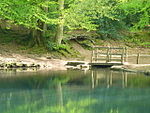Lynchmere Commons
Local Nature Reserves in West Sussex

Lynchmere Commons is a 122-hectare (300-acre) Local Nature Reserve in Lynchmere in West Sussex. It is owned and managed by the Lynchmere Society.This heathland site is composed of Stanley, Lynchmere and Marley Commons. They have diverse insect species and unusual plants such as bilberries.
Excerpt from the Wikipedia article Lynchmere Commons (License: CC BY-SA 3.0, Authors, Images).Lynchmere Commons
Danley Lane, Chichester Linchmere
Geographical coordinates (GPS) Address Nearby Places Show on map
Geographical coordinates (GPS)
| Latitude | Longitude |
|---|---|
| N 51.072 ° | E -0.768 ° |
Address
Danley Lane
Danley Lane
GU27 3NF Chichester, Linchmere
England, United Kingdom
Open on Google Maps



